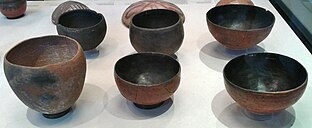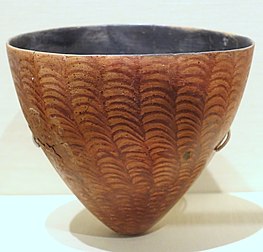A-Group culture

| Chalcolithic Eneolithic, Aeneolithic, or Copper Age |
|---|
|
↑ Stone Age ↑ Neolithic |
|
↓ Bronze Age ↓ Iron Age |
The A-Group culture was an ancient culture that flourished between the First and Second Cataracts of the Nile in Nubia. It lasted from c. 3800 BC to c. 3100 BC.[1]
Overview

In 1907, the Egyptologist George A. Reisner first discovered artifacts belonging to the A-Group culture.[2] Early hubs of this civilization included Kubaniyya in the north and Buhen in the south, with Aswan, Sayala, Toshka and Qustul in between.[1]
The A-Group population have been described as ethnically “very similar” to the pre-dynastic Egyptians in physical characteristics.[3] The A-Group makers maintained commercial ties with the Ancient Egyptians. They traded commodities like incense, ebony and ivory, which were gathered from the southern riverine area. They also bartered carnelian from the Western Desert as well as gold mined from the Eastern Desert in exchange for Egyptian products, olive oil and other items from the Mediterranean basin.[1]
Excavation Findings

The A-Group makers left behind a number of cemeteries, with each necropolis containing around fifty graves. Most of what is known about this culture has been gleaned from these tombs, over 3,000 of which have been excavated. The burials are of two kinds: a more common oval pit, and a similar pit featuring a lateral funerary niche. Skeletons found within these graves were observed to be physically akin to their peers in Upper Egypt. The specimens typically had straight hair of a black or dark brown hue. On average, the men were 169.9 cm in height and the women stood around 155.5 cm. Some individuals were wrapped in leather and positioned on reed mats. All of the tombs contained various burial items, including personal ornaments, utensils and ceramics.[4]
Dental trait analysis of A-Group fossils found affinities with populations inhabiting Northeast Africa the Nile valley, and East Africa. Among the sampled populations, the A-Group people were nearest to the Kerma culture bearers and Kush populations in Upper Nubia and to Ethiopians, followed by the Meroitic, X-Group and Christian period inhabitants of Lower Nubia and the Kellis population in the Dakhla Oasis, as well as C-Group and Pharaonic era skeletons excavated in Lower Nubia and ancient Egyptians (Naqada, Badari, Hierakonpolis, Abydos and Kharga in Upper Egypt; Hawara in Lower Egypt).[5]
In 2007, Strouhal et al described the physical features of ancient A-Group Nubians as "Caucasoid" which were "not distinguishable from the contemporary Predynastic Upper Egyptians of the Badarian and Nagadian cultures" based in reference to previous anthropological studies from 1975 and 1985.[6]
In 2020, Kanya Godde analysed a series of crania which included two Egyptian (predynastic Badarian and Naqada series), a series of A-Group Nubians, and a Bronze Age series from Lachish, Palestine. The two pre-dynastic series had strongest affinities, followed by closeness between the Naqada and the Nubian series. Further, the Nubian A-Group plotted nearer to the Egyptians and the Lachish sample placed more closely to Naqada than Badari. According to Godde the spatial-temporal model applied to the pattern of biological distances explains the more distant relationship of Badari to Lachish than Naqada to Lachish as gene flow will cause populations to become more similar over time. Overall, both Egyptian samples were more similar to the Nubian series than to the Lachish series.[7][8]
Excavations at an A-Group cemetery in Qustul yielded an old incense burner, which was adorned with Ancient Egyptian royal iconography. However, further research established the antecedence of the predynastic Egyptian regalia:
The earliest known examples of Egyptian royal iconography, such as, e.g., the representation of the Red Crown on a late Naqada I (c. 3500 BC) pottery vessel from Abydos or the triumphal scenes in the painting from Hierakonpolis Tomb 100 (c. 3400-3300 BC) are much older than the Qustul censer. It seems thus that it was the Qustul rulers who adopted symbols of royal authority developed in Egypt and not vice versa.[9]
More recent and broader studies have determined that the distinct pottery styles, differing burial practices, different grave goods and the distribution of sites all indicate that the Naqada people and the Nubian A-Group people were from different cultures. Kathryn Bard further states that "Naqada cultural burials contain very few Nubian craft goods, which suggests that while Egyptian goods were exported to Nubia and were buried in A-Group graves, A-Group goods were of little interest further north."[10] Nubian excavations in Serra East found that the bodies buried in the A-Group cemeteries would lay on either side with their head facing south or east. Similar to that of a curled-up position, their hands could be found near the face and their legs folded-in upwards. Leather wrappings were also found in the burials as a means of clothing and bags. However, this leather wrapping was not typically found in more lavish cemeteries, such as Cemetary L at Qustul. As for distinct pottery styles, decorative vessels were more likely to be found in larger tombs at Qustul, whereas simpler burial arrangements contained ripple-burnished or simple vessels.[11] However, the archaeological cemeteries at Qustul are no longer available for excavations since the flooding of Lake Nasser.[12]
Oshiro Michinori argued, in reference to the A-Group culture, that the external influence from Nubia on the formation of Ancient Egypt in the pre-dynastic period to the dynasty period predates influence from eastern Mesopotamia. He notes an increase in the appreciation of the contribution of Nubia in the south to Ancient Egyptian culture at the time of his writing. According to him, chiefs of the same cultural level as Upper Egyptian powers existed in Lower Nubia and exhibited pharaonic iconography before the unification of Egypt.[13]
A-Group Linguistics
The linguistic affinity of the A-Group culture is unknown, but, according to Claude Rilly, it is unlikely to have spoken a language of the Northern East Sudanic branch of Nilo-Saharan. Beyond this Rilly states that "the range of possibilities remains wide" and includes: a language belonging to another (non-Northern East Sudanic) branch of the Nilo-Saharan family, a Cushitic language, or other Afro-Asiatic language.[14]
Debate about the Origin of the First Pharaohs
In 1980, archeologist Bruce Williams conducted an excavation titled “The Lost Pharaohs of Nubia,” arguing that the Egyptian pharaonic monarchy was situated in Nubia, rather than in Egypt during the times of the A-group. He based his discoveries at the Qustul cemetery on three archaeological finds: the size of the tombs, their plethora of contents, and royal iconography (such as pottery vessels and stone censers).[15] His claims, however, lead to criticism and defense from scholars such as William Y. Adams and Maria Carmela Gatto, respectively. Gatto argued that Bruce Williams explicitly denied making such a sweeping claim, saying that he was only trying to "raise the strong possibility that Egypt’s founding dynasty originated near Qustul and that the unification was accomplished from Nubia.” Gatto added that "Whatever the claim, the (for some scholars) inconceivable idea of a primary role for Nubia in the rise of the Egyptian monarchy has been reconsidered after more recent finds in Upper Egypt dating back to the Naqada I period the early manifestations of elite iconography." while noting "That the tombs found in Qustul were exceptional and comparable to those of the earliest Egyptian rulers remains, nevertheless, a fact."[16] While Gatto mentions that the tombs found in Qustul were comparable to that of Egyptian ruler's tombs, William Y. Adams suggests that the large size and contents of their grave support an approach different from that of Bruce Williams. He states that “The large tombs and their abundant contents may argue for a more stratified society than we had previously envisioned in the A-group period, but they are not evidence for a monarchical state.” [17] Adams also argues that the Qustul incense burner found in the cemetery may be better suited to prove that the monarchy was situated somewhere near the Nile Valley instead of the monarchy being initially situated in Nubia.


Existential Crisis of the B-Group
The A-Group culture came to an end around 3100 BCE, when it was destroyed, apparently by the First Dynasty rulers of Egypt.[1] Following the A-Group culture, Reisner originally identified a B-Group and C-Group culture that existed within Nubia. However, this theory became obsolete when Henry S. Smith demonstrated that the "B-Group" was an impoverished manifestation of the A-Group culture.[18] With the existential crisis of the B-Group, it is suggested that these burials were simply poorer versions of A-group burials and that the span of the A-group culture lasted beyond 3100 BCE.[17]
References
- ^ a b c d "Ancient Nubia: A-Group 3800–3100 BC". The Oriental Institute. Retrieved 1 July 2016.
- ^ Shinnie, Peter L. (2013). Ancient Nubia. Routledge. p. 43. ISBN 978-1136164651. Retrieved 30 June 2016.
- ^ Mohktar, Gamal (1981). General History of Africa volume 2: Ancient Civilizations of Africa: (Unesco General History of Africa. London: Heinemann Educational Books. p. 148. ISBN 978-0435948054.
- ^ Shinnie, Peter L. (2013). Ancient Nubia. Routledge. p. 50. ISBN 978-1136164651. Retrieved 30 June 2016.
- ^ Haddow, Scott Donald. "Dental Morphological Analysis of Roman Era Burials from the Dakhleh Oasis, Egypt". Institute of Archaeology, University College London. Retrieved 2 June 2017.
- ^ Strohaul, Eugene. "Anthropology of the Egyptian Nubian Men - Strouhal - 2007 - ANTHROPOLOGIE" (PDF). puvodni.mzm.cz: 115.
- ^ Godde, Kane. "A biological perspective of the relationship between Egypt, Nubia, and the Near East during the Predynastic period (2020)". Retrieved 16 March 2022.
- ^ Crawford, Keith W. (2021). "Critique of the "Black Pharaohs" Theme: Racist Perspectives of Egyptian and Kushite/Nubian Interactions in Popular Media". African Archaeological Review. 38 (4): 695. ISSN 0263-0338.
- ^ Török, László. Between Two Worlds : The Frontier Region Between Ancient Nubia and Egypt, 3700 BC-AD 500. In Probleme Der Ägyptologie. Leiden: Brill. 2009. ISBN 9789004171978
- ^ An Introduction to the Archaeology of Ancient Egypt, by Kathryn A. Bard, 2015, p. 110
- ^ "OINE 10. Excavations at Serra East, Parts 1-5: A-Group, C-Group, Pan Grave, New Kingdom, and X-Group Remains from Cemeteries A-G and Rock Shelters | The Oriental Institute of the University of Chicago". oi.uchicago.edu. Retrieved 2022-10-30.
- ^ Lobban, Richard A. Jr. (20 October 2020). Historical Dictionary of Medieval Christian Nubia. Rowman & Littlefield. p. 163. ISBN 978-1-5381-3341-5.
- ^ OHSHIRO, Michinori (2000). "The Nubian A-Group and Qustul Incense Burner A View of the Formation Period of Ancient Egypt". Bulletin of the Society for Near Eastern Studies in Japan. 43 (1): 103–118. doi:10.5356/jorient.43.103. ISSN 0030-5219.
- ^ Rilly, Claude (2019). "Languages of Ancient Nubia". In Raue, Dietrich (ed.). Handbook of Ancient Nubia. Walter de Gruyter GmbH & Co KG. p. 134. ISBN 978-3-11-042038-8.
- ^ Williams, Bruce (1980). The Lost Pharaohs of Nubia. Archaeology 33.
- ^ Emberling, Geoff; Williams, Bruce (2020). The Oxford Handbook of Ancient Nubia. Oxford University Press. p. 126. ISBN 978-0-19-049627-2.
- ^ a b Adams, William Y. (1985). "Doubts about the "Lost Pharaohs"". Journal of Near Eastern Studies. 44 (3): 185–192. ISSN 0022-2968.
- ^ Smith, Harry Sidney (1966). "The Nubian B-Group" (PDF). Kush: Journal of the Sudan Antiquities Service. 14: 69–124. Retrieved 29 May 2021.
External links
- Early States and the A-Group 'Proto-Kingdom'[usurped]
- Regional variations in the so-called “A-Group” Culture of Lower Nubia
- Hans-Åke Nordstrom : The Nubian A-Group
- Maria Gatto: Hunting for the Exclusive Nubian A-Group People; Renée Friedman: Setting the Scene
- Nubian Cultures: A and C-Group
- Early Burials: A-Group and C-Group[usurped]
- The Exhibit of Nubian Antiquities
- Nancy C. Lovell: Nubian A- and C-Groups
- Maria Carmela Gatto: The Nubian A-group: a reassessment
